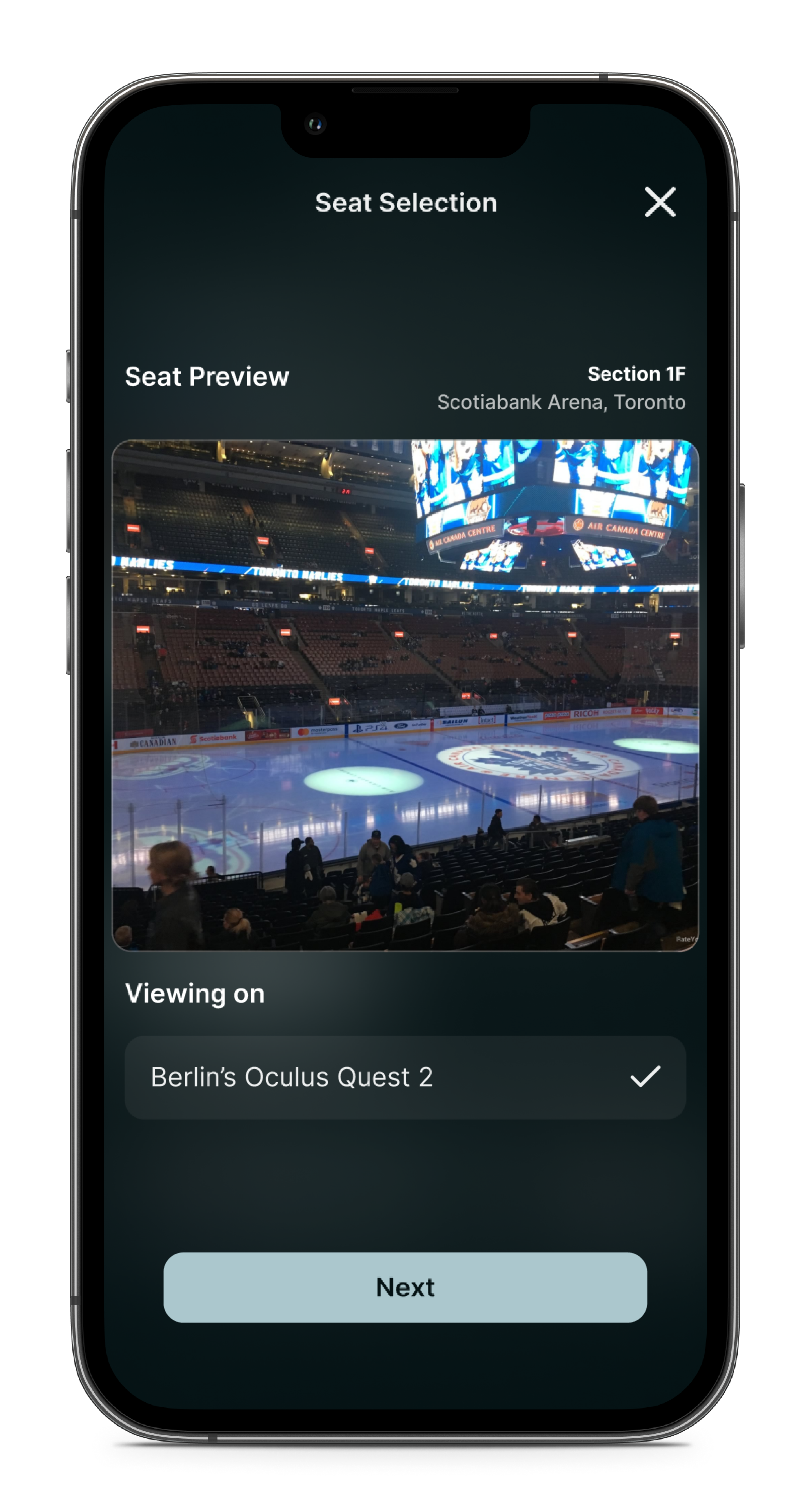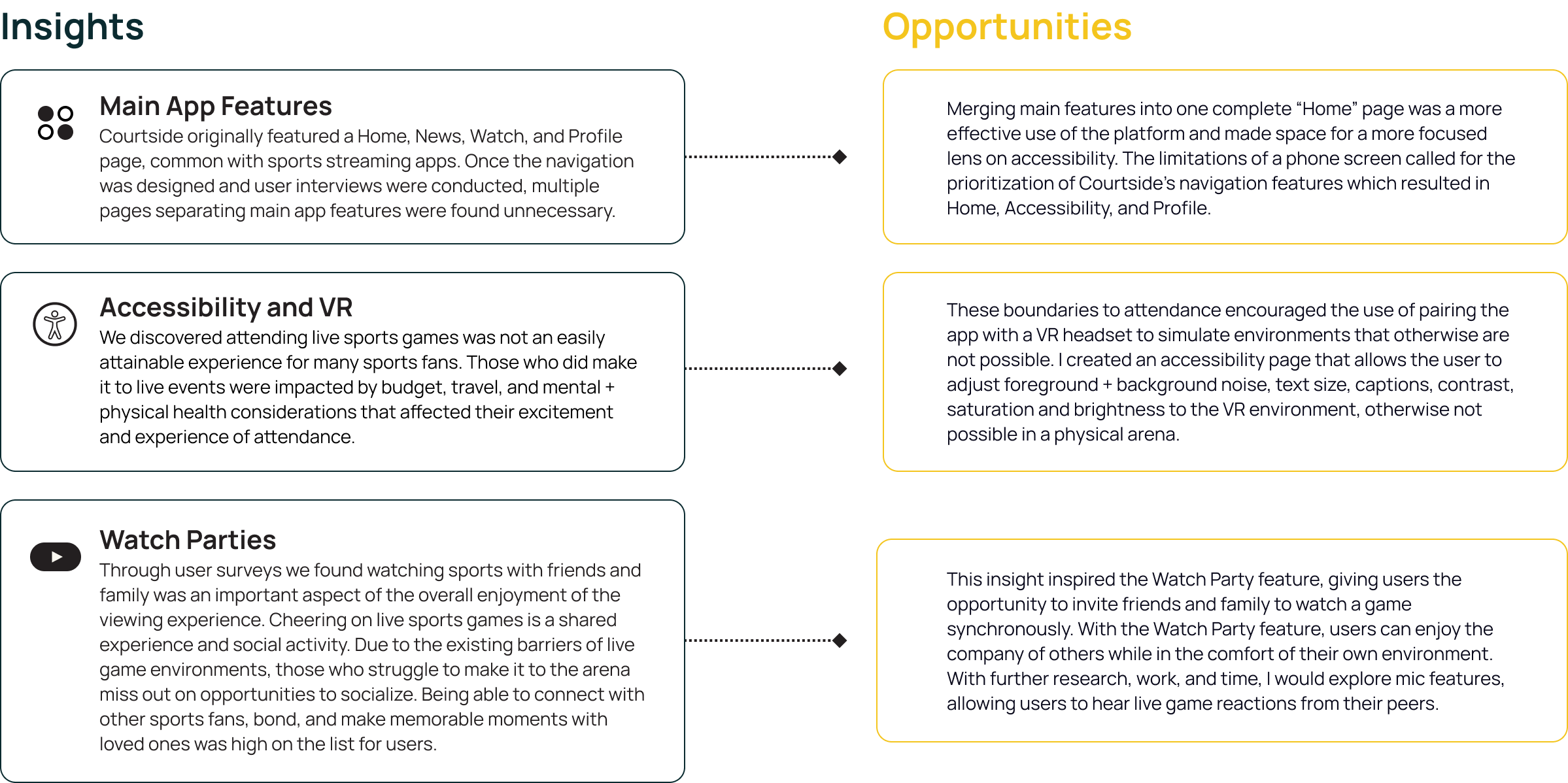A VR compatible sports streaming mobile app with a focus on affordability and digital accessibility.

Research, Ideation, UX/UI, Visual design, Prototyping
April 2022 (2 weeks)
Berlin Pang, Carter Pang
Figma, Photoshop

Problem
Attending a live sports game in person is an immersive, connected experience among many sports fans.
However, these experiences can have various barriers to access and be affected based on fans’ limitations; distance, budget, physical disability, health etc.
Often the convenient outcome is to not attend a live game, but watch or stream the game at home. This results in the notion that live sports events are expensive, inaccessible, exclusive and unsafe due to the spread of COVID-19.
How might we make experiencing live sports events more accessible for fans?

Solution
Courtside is a mobile app platform that pairs with compatible VR headsets to stream live sports games and generate an immersive viewing experience for fans near and far.
The key features of Courtside include: a watch party feature that allows our users to invite their friends to simultaneously tune into games, a game hub to view what games are scheduled, a live stats news feed, and a member profile page.
It was important we were receptive to people with visible and non-visible disabilities. Arena’s can be overwhelming spaces for those who need mobility aids, have hypersensitivities, or health risks. Courtside features an accessibility page devoted to sound, brightness, closed-captions, colour, visual aids and other obstacles that interfere with our user’s experiences.
Using VR provides an accessible, realistic experience for users, especially those with physical disabilities, and allows them to participate without facing the limitations of their disability. This promotes inclusivity, and creates an equal opportunity for users to have a similar viewing experience.





Our Approach

Research: Contextualizing our project, empathizing with users, identifying and understanding the problem

Benchmark Analysis
We conducted market research to identify and analyze the current existing apps in our product’s market. We found there was opportunity for a paired app with headset, as sports VR is a newer technology and is yet to have a paired application. DAZN Live Sports Streaming, fuboTV, ESPN, and CBS Sports are apps available for sports fans, however, only livestream games from mobile, giving the user the same experience as watching a game on TV. The top-rated VR apps available for watching sports in VR are MLB VR, NBA Horizon Venues, ESPN Oculus App, and NBC Olympics VR by Xfinity, with the most advanced experience being NBC Olympics VR, that allows the user in-person views of the sports they are watching. The other apps simply immerse the user in a virtual environment where they can watch a game through a screen in the simulated reality using controllers as tv remotes.

User Surveys
Once we established our place in the market, we conducted user surveys to develop personas and gain general insights to our users.
We created multiple short answer surveys that were sent to potential users that had previously attended live sports events, had established boundaries to attendance, and were open to viewing alternatives.

User Interviews
We spoke to avid sports fans, all coming from different walks of life, to better understand both the entertainment value and personal limitations they face as viewers attending a live game. From there we identified user pain points, deconstructed biases, and began researching new streams of information.
Our team gained 3 key insights from our research, which allowed us to re-design and implement features more suitable for our users. Here are the 3 key insights we gained:


Developing Personas
When designing our product we decided to focus on outcomes, rather than app features. Working from this perspective helped us understand what was necessary to make the app accessible and how to integrate seamlessly with the rest of the user experience.
Our overall findings revealed that their experiences were impacted heavily depending on where they lived, mental and physical health, budgets, and lifestyle. Convenience was another characteristic that affected how often user’s were attending live games and created excitement for the potential of our product.
This validated the objectives Courtside hopes to accomplish; create an accessible experience for everyone with tools and technology anybody can use.
We built three personas based on our data to represent users of different capabilities and situations, to gain a better sense of our user perspectives.
Ideation: Conceptualizing new ideas and developing our solutions

Information Architecture
Due to the quick paced nature of this project we solely built the IA diagram, as Courtside features simple UI. We determined four main navigations; Home, News, Accessibility and Profile, with News using scroll navigation along the main home page. Having accessibility as a main navigation was a design choice made to highlight its importance to our team, and to normalize its presence somewhere other than in settings.


Low-Fidelity
After establishing Courtside’s feature requirements we sketched low-fidelity screens for mobile. This took multiple iterations to complete as we re-designed our main functionalities and layouts based on usability and aesthetics.

Prototyping: Bringing our concepts and visuals to fruition through simulated screens

Visual Design System
Our team visualized our brand identity through establishing some key terms to inspire our visuals, copy, and user flows;
Visuals: Clean, confident, and high-contrast
Copy: Focused, dynamic, and insightful
User Flows: Polished, purposeful, and clear
Overall design: Suave, determined, and organized
We built our design system to streamline our prototyping process and create consistency across our product.
User testing: Making necessary changes to our prototype through user feedback

User Testing
We worked with users to test the usability of our flows through explorative tests, assessment research, moderated, and unmoderated testing. We ran user testing with the following users; lived close or far to sports centres, did or did not have physical limitations, and did or did not have hyper-sensibilities.
Unfortunately, we were only able to test the interactive prototype as we didn’t have the tools and time to simulate a VR system. Using a VR headset in partnership with our product was something we could only discuss in concept. This undoubtedly affects how realistic our user feedback is, however we were able to make positive changes to our interfaces, pinpoint gaps, and workshop new ideas, leaving us with a better product.
Based on our user feedback, we implemented a series of modifications that addressed several issues. The following changes are below:
A VR compatible sports streaming mobile app with a focus on affordability and digital accessibility.

Account Creation
Simple account set-up with standard email, password, and two-step verification. Alternative login flow once user has created an account

Select VR Device
Users can sync their compatible VR device headsets to Courtside’s platform. Users select their VR headset through the device selection dropdown

Games Dashboard
Courtside’s home screen displays live and future sports games from the NFL, NHL, MLB, ML, and NBA. Users can scroll through the available games through sports league tabs

Game Sheet
Through selecting a game on the home screen, users are brought to Courtside’s game sheet which showcases live scores, key game events, watch party features, news, highlights, and live-streaming

Seat Selection
After selecting a game’s live-stream, users are brought to seat selection to choose where they will view the game from. Once selected, users will be shown a seat preview before receiving their virtual ticket to begin watching the event

Accessibility Menu
The accessibility page allows for users to customize the closed captioning, font size, contrast, saturation, text spacing, screen brightness and sound of their VR environment

Profile
Courtside’s user profiles feature their membership status, number of games watched, and favourite teams. The profile also displays upcoming games through the game dashboard and past games watched

Reflection
Courtside was an exciting opportunity to work on a smaller scope project. Although working extensively on a project until its fully fleshed out is ideal, working quickly through a problem space is a great challenge. I was fortunate to find time to work closely on each facet of the project, to fully understand it’s objectives and have my hand in each solution. With more time I would have liked to do more thorough research to incorporate solutions to combat cyber-sickness and other obstacles VR has.
I would have also liked to design a prototype for a VR headset interface to close the gap between the mobile app and headset screen. I know there is a practical solution to building a seamless connection between these two technologies, and would love to explore what that is.
One of my favourite parts of working on Courtside was working on a product that was receptive to disability, as I’ve been waiting to learn more about how to build a positive, inclusive space for all users. It was extremely important to recognize the reality of disability, to truly provide support to those who need it. Two weeks is not nearly enough time spent on building the most suitable features for this community but I hope to open the conversation on providing accessible digital spaces and make steps towards improvement.
It was rewarding to work short-term on a project, be comfortable with the result, and see room for growth and exploration in the future.
As the world becomes more reliant on technology, it’s clear it needs to work for everyone. Steps toward inclusive design are essential to make meaningful connections and create shared experiences.